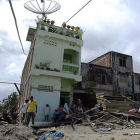By: Naomi Martin
Send to a friend
The details you provide on this page will not be used to send unsolicited email, and will not be sold to a 3rd party. See privacy policy.
A dispute has broken out over who should take responsibility for the lack of an early enough warning for residents of Indonesia’s Mentawai islands, who were struck by a three-metre tsunami this week.
Residents have said they received no early warning and an official from the Indonesian Climatology Agency blamed the failure on a faulty alert system.
But the organisations that developed and established the alert system, the GFZ German Research Centre for Geosciences and UNESCO’s (UN Educational, Scientific and Cultural Organisation) Intergovernmental Oceanographic Commission (IOC) have since claimed that the system worked fine and timely alerts were sent.
The tsunami was triggered by a magnitude 7.7 earthquake off the coast of western Sumatra, and killed more than 400 people — mostly on the Mentawai islands.
Ferdinand Salamanag, a resident of North Pagai island told BBC News that although their port has an earthquake and tsunami detection system, they did not hear any warning.
Speaking to Sky News, Fauzi, an official at the Indonesian Climatology Agency, claimed that by last month the country’s early warning system — the Indonesian Tsunami Early Warning System (InaTEWS) — had broken down because of inexperienced operators and that, as a result, not a single siren sounded after the earthquake.
Ridwan Jamaluddin, of Indonesia’s Agency for the Assessment and Application of Technology, told BBC News that two buoys — floats moored in water to detect sudden water-level changes — off the coast of the islands had been vandalised and were therefore out of service.
But Bernardo Aliaga, a programme specialist with UNESCO’s IOC, told SciDev.Net that InaTEWS was functioning properly and did, in fact, issue a warning to residents and the national authorities within just five minutes of the earthquake.
"The buoys are only part of the warning system," Aliaga said. "The fact that two buoys were broken would not have affected it. The only information you need to issue a warning is seismic information: magnitude, location of the epicentre and so on."
He added that UNESCO has proof that residents received a text message warning that there was a tsunami.
And the Indonesian Agency for Meteorology, Climatology and Geophysics (BMKG), confirmed at a press conference yesterday (28 October) that despite the vandalised buoys, the system was functioning.

The Indonesian tsunami alert system was set up after the devastating 2004 tsunami
Wikipedia Commons
"The amount [of buoys] that are missing is not that significant," said Sriworo Harijanto, director-general of the agency. "The system is working well and we did issue a warning five minutes after the earthquake."
The GFZ German Research Centre for Geosciences, who helped develop and build the system, also rejected claims that it had malfunctioned.
"Reports of broken or even deliberately destroyed system units are entirely unfounded," they said in a statement issued yesterday. The problem, Aliaga said, is that the earthquake occurred so close to the Mentawai islands that even such a swift warning could not reach villages before the tsunami struck.
"When the first wave arrives in minutes, there is no time to wait for an official warning," he said, "people need to react immediately." He added that this was especially true in this instance, as the earthquake struck so close to the islands.
Aliaga said that efforts to educate communities in earthquake and tsunami preparedness are essential.
"I’m pretty sure many of the villages did [feel the earthquake] and saved their lives because they knew what to do."
Brent McInnes, director of the John De Laeter Centre and Research Professor for Isotope Research for the Earth and Environment at Curtin University, Australia, said: "No one is to blame for not providing adequate warning — as there is no practicable way of evacuating hundreds or thousands of people … due to their proximity to the earthquake zone. The best thing to do is to exclude people from living in these areas."
Kevin McCue, director of the Australian Seismological Centre, said that InaTEWS worked "as well as could be expected".
"What failed was the education process — only some of the people fled to higher ground and one of the boats put to sea immediately after they felt the earthquake — the right thing to do in these circumstances. Why wasn’t everyone well prepared to respond given the recent history of earthquakes and tsunamis in the region?"
Nalaka Gunawardene, director of TVE Asia Pacific, a not-for-profit media group, hinted at underlying problems with the system’s suitability for its environment.
Gunawardene told SciDev.Net that tsunami early warning systems installed after the 2004 tsunami "focused on the technology and overlooked the institutional arrangements and local capacity".
He added: "The elaborate and expensive early warning systems installed after the 2004 tsunami have run into various problems of maintenance. Some were too sophisticated or too fragile for the rustic tropical Asian conditions. As a result, some of these systems are not in a state of readiness to swiftly and decisively handle a tsunami warning on a 24/7 basis."
Link to GFZ German Research Centre for Geosciences statement
Nalaka Gunawardene is a trustee of SciDev.Net.













